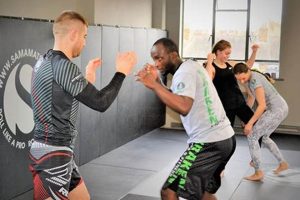Introductory mixed martial arts (MMA) training provides foundational skills in various combat disciplines, including striking, grappling, and wrestling. A typical introductory course might involve learning basic punches, kicks, takedowns, and defensive maneuvers. These classes often emphasize proper form and technique over sparring, creating a safe learning environment.
Structured training in a supervised setting offers a safe and effective way to learn the complexities of MMA. It builds physical fitness, enhances self-defense capabilities, and instills discipline and focus. Historically, MMA evolved from a more combative, less regulated format into a mainstream sport with codified rules and training methodologies. This evolution has led to the development of structured beginner programs that prioritize safety and fundamental skill development.
This discussion will further explore various aspects of introductory MMA training, such as finding the right gym, essential equipment, and training expectations. It will also delve into the physical and mental benefits derived from the discipline.
Tips for Starting MMA Training
Beginning mixed martial arts training can feel daunting. These tips offer guidance for individuals embarking on this journey.
Tip 1: Research Local Gyms Thoroughly: Different gyms emphasize different aspects of MMA. Some might specialize in Brazilian Jiu-Jitsu, while others focus on Muay Thai. Visiting prospective gyms, observing classes, and speaking with instructors provides valuable insight.
Tip 2: Start Slowly and Listen to Your Body: MMA training is physically demanding. Avoid overtraining, especially in the initial stages. Rest and recovery are crucial for preventing injuries and ensuring long-term progress.
Tip 3: Focus on Fundamental Techniques: Mastering basic punches, kicks, and grappling techniques is essential before progressing to more advanced maneuvers. Solid fundamentals build a strong foundation for future development.
Tip 4: Invest in Proper Equipment: While some gyms provide loaner equipment, investing in quality gloves, hand wraps, and mouthguards is recommended for hygiene and optimal protection.
Tip 5: Maintain a Consistent Training Schedule: Regular training sessions maximize skill development and physical conditioning. Consistency promotes muscle memory and builds overall proficiency.
Tip 6: Embrace the Learning Process: Everyone starts as a beginner. Embrace the challenges, ask questions, and be patient with the learning process. Progress takes time and dedication.
Tip 7: Prioritize Proper Nutrition and Hydration: Fueling the body with nutritious foods and staying hydrated supports optimal performance and recovery.
By adhering to these guidelines, individuals can embark on their MMA journey with confidence and build a solid foundation for success in the sport.
This information provides a starting point for individuals considering MMA training. Further research and consultation with experienced instructors will enhance preparation and ensure a positive training experience.
1. Fundamental Techniques
Fundamental techniques form the bedrock of effective mixed martial arts training, particularly for beginners. A strong grasp of these basics allows for the safe and effective execution of more complex maneuvers. This foundational knowledge includes proper stance, footwork, basic strikes (punches, kicks, knees, elbows), and fundamental grappling techniques (takedowns, escapes, and basic submissions). For example, a solid understanding of a proper fighting stance provides balance and stability, crucial for both offensive and defensive maneuvers. Similarly, mastering basic punches like the jab and cross creates a foundation for developing more advanced combinations and power generation.
Neglecting fundamental techniques can lead to inefficient movement, reduced power, and increased susceptibility to injury. Beginners who prioritize mastering these core elements often progress more quickly and safely than those who rush into advanced techniques before establishing a solid base. For instance, attempting complex submissions without understanding the underlying principles of leverage and control can result in ineffective application and potential harm to both the practitioner and training partner. Further, a strong foundation in fundamental techniques allows for greater adaptability and responsiveness in sparring situations.
In summary, prioritizing fundamental techniques in beginner MMA classes provides a crucial framework for safe and effective training. This emphasis on foundational skills fosters proper biomechanics, reduces injury risk, and lays the groundwork for continued progression within the discipline. Building this strong base allows beginners to develop the necessary skills and confidence to explore more advanced techniques effectively and safely as they advance in their training.
2. Gym Selection
Appropriate gym selection significantly impacts the effectiveness and enjoyment of introductory mixed martial arts training. A suitable training environment fosters skill development, promotes safety, and cultivates a supportive community. Choosing a gym aligned with individual needs and goals constitutes a crucial first step for beginners.
- Instructor Expertise and Credentials:
Qualified instructors possess extensive experience and recognized certifications. They demonstrate a deep understanding of MMA principles, effective teaching methodologies, and safety protocols. A coach with a proven track record of developing beginners can significantly influence skill progression and minimize injury risk. For instance, an instructor with a black belt in Brazilian Jiu-Jitsu and extensive coaching experience offers valuable expertise in grappling techniques.
- Class Structure and Curriculum:
Well-structured classes follow a logical progression, building upon fundamental techniques. A comprehensive curriculum covers key aspects of MMA, including striking, grappling, and wrestling. Beginner classes should emphasize proper form, technique refinement, and controlled sparring. For example, a class dedicated to takedown defense provides valuable skills applicable in various MMA scenarios.
- Training Environment and Culture:
A positive and supportive training environment fosters learning and encourages growth. A gym with a respectful and encouraging atmosphere promotes camaraderie among students and creates a sense of community. Observing a class allows prospective students to assess the gym’s culture and training dynamics. A clean and well-maintained facility further indicates a commitment to safety and professionalism.
- Schedule and Accessibility:
A convenient schedule and accessible location facilitate consistent training, a key factor in skill development. Flexible class times accommodate varying schedules and allow individuals to integrate training into their routines. Proximity reduces travel time and increases the likelihood of consistent attendance. Multiple class options throughout the day cater to diverse schedules and preferences.
Careful consideration of these factors ensures the selection of a gym that aligns with the specific needs and goals of individuals embarking on their MMA journey. A suitable training environment maximizes learning potential, supports progress, and fosters a positive experience within the discipline. The right gym provides the foundation for a rewarding and successful MMA experience for beginners.
3. Safety Precautions
Safety precautions constitute a critical component of introductory mixed martial arts training. The inherent physicality of MMA necessitates a strong emphasis on risk mitigation to prevent injuries and ensure a positive learning experience. Beginners, particularly those unfamiliar with combat sports, benefit significantly from structured environments that prioritize safety protocols. A comprehensive approach to safety encompasses several key elements, from proper warm-up routines to the supervised application of techniques.
Proper warm-up routines prepare the body for the physical demands of training, reducing the risk of muscle strains and other injuries. Instructors play a vital role in demonstrating and enforcing correct warm-up procedures. For example, dynamic stretching, which involves controlled movements through a range of motion, enhances muscle flexibility and blood flow, preparing the body for the subsequent training activities. Similarly, the supervised practice of techniques minimizes the risk of injury due to improper execution. Instructors provide real-time feedback and corrections, ensuring students develop proper form and technique before engaging in more intense training. For instance, during grappling practice, instructors emphasize controlled movements and safe methods of applying submissions, reducing the risk of joint injuries.
The use of appropriate protective gear, such as mouthguards, hand wraps, and gloves, further mitigates injury risk. These protective measures cushion impact, stabilize joints, and prevent lacerations. Furthermore, adhering to established rules and guidelines within the training environment reinforces safe practices. Respectful conduct during sparring sessions, including controlled power and adherence to technique limitations, creates a safe training space for all participants. A culture of safety, fostered by both instructors and students, minimizes preventable injuries and promotes a positive training environment. Consistent adherence to safety precautions allows beginners to focus on skill development and enjoy the learning process without undue risk. This emphasis on safety fosters confidence and encourages long-term participation in the sport.
4. Consistent Training
Consistent training forms the cornerstone of progress in introductory mixed martial arts. Regular engagement develops the requisite muscle memory, enhances cardiovascular fitness, and builds proficiency in fundamental techniques. For beginners, consistent practice translates to tangible improvements in skill execution, physical conditioning, and overall confidence. This dedication lays the groundwork for sustained growth and a deeper understanding of the discipline.
- Skill Development and Muscle Memory:
Regular practice reinforces learned techniques, ingraining proper form and execution into muscle memory. Repeated drills and exercises enhance neuromuscular coordination, leading to smoother and more efficient movements. For example, consistent practice of a jab-cross combination leads to quicker execution and improved accuracy.
- Cardiovascular Conditioning and Endurance:
MMA training demands high levels of cardiovascular fitness. Consistent participation builds endurance, allowing individuals to sustain intense activity for extended periods. Regular sparring sessions and conditioning drills improve cardiovascular capacity, enabling individuals to perform techniques effectively without excessive fatigue. Improved endurance translates to better performance and reduced susceptibility to injury.
- Increased Strength and Power:
Consistent training strengthens muscles used in striking, grappling, and takedowns. Weight training, bodyweight exercises, and resistance drills contribute to increased power generation and improved overall strength. For example, regular strength training enhances punching power and grappling control.
- Enhanced Mental Fortitude and Discipline:
The demanding nature of MMA training cultivates mental resilience and discipline. Overcoming physical challenges and pushing personal limits builds mental toughness and fosters a sense of accomplishment. Consistent training instills discipline, promoting adherence to training schedules and a commitment to continuous improvement.
The cumulative effect of consistent training manifests in demonstrable progress for beginners in mixed martial arts. This dedication fosters not only physical improvements but also mental fortitude and a deeper appreciation for the discipline. Consistent engagement reinforces foundational skills, enhances physical conditioning, and cultivates the discipline necessary for long-term success in MMA. This commitment to consistent training sets the stage for continued growth and a rewarding journey within the sport.
5. Realistic Expectations
Cultivating realistic expectations constitutes a crucial element of a positive and productive experience in introductory mixed martial arts training. Beginners entering MMA often harbor preconceived notions influenced by media portrayals or anecdotal accounts, which may not accurately reflect the realities of training. Understanding the actual progression involved in skill acquisition, physical conditioning, and overall development sets the stage for sustained engagement and minimizes the potential for discouragement. For instance, expecting to master complex techniques or attain a high level of fitness within a short timeframe is unrealistic and can lead to frustration. Recognizing that progress occurs incrementally, through consistent effort and dedicated practice, fosters a more balanced and sustainable approach to training.
A realistic outlook acknowledges the physical and mental demands of MMA training. It accounts for the time commitment required to develop proficiency, the challenges inherent in learning new skills, and the potential for setbacks along the way. Embracing the learning process, with its inherent challenges and triumphs, promotes long-term commitment and allows beginners to appreciate the journey of growth and self-improvement. For example, understanding that soreness and fatigue are common occurrences, especially during the initial stages of training, helps individuals manage expectations and avoid premature discouragement. Similarly, acknowledging that skill development takes time, often involving repeated practice and refinement, fosters patience and perseverance.
In summary, establishing realistic expectations from the outset contributes significantly to a successful and fulfilling experience in introductory mixed martial arts training. This grounded perspective allows beginners to approach training with patience, resilience, and a focus on continuous improvement. It fosters a growth mindset, which emphasizes the importance of effort, perseverance, and self-belief in the face of challenges. This realistic approach, coupled with consistent training and a supportive learning environment, paves the way for long-term engagement and meaningful progress within the discipline.
Frequently Asked Questions
This section addresses common inquiries regarding introductory mixed martial arts training. Clear and concise answers provide prospective trainees with the information necessary to make informed decisions and approach training with realistic expectations. These responses aim to clarify potential uncertainties and address common misconceptions.
Question 1: What level of fitness is required to begin MMA training?
While a base level of fitness is beneficial, individuals can begin training with varying fitness levels. Introductory classes cater to beginners and progressively build strength and endurance. Consistent participation naturally improves fitness over time.
Question 2: Is prior experience in martial arts necessary?
Prior experience is not a prerequisite. Beginner classes assume no prior knowledge and focus on fundamental techniques. Experienced instructors adapt their teaching methods to accommodate varying skill levels.
Question 3: How often should one train in a week?
Training frequency depends on individual schedules and goals. Two to three sessions per week generally provide sufficient volume for beginners to develop skills and improve fitness. Consistency is more crucial than frequency.
Question 4: What equipment is necessary for introductory classes?
Many gyms offer loaner equipment for beginners. However, investing in personal gloves, hand wraps, and a mouthguard is recommended for hygiene and optimal fit. Instructors can provide guidance on appropriate equipment selection.
Question 5: How long does it take to see noticeable progress?
Progress varies based on individual aptitude, training frequency, and dedication. Consistent training typically yields noticeable improvements in technique, fitness, and confidence within several months. Focusing on consistent effort rather than immediate results fosters long-term growth.
Question 6: Is MMA training safe for beginners?
Structured beginner classes prioritize safety. Instructors emphasize proper technique, controlled sparring, and the use of protective gear to minimize injury risk. Adhering to safety guidelines and training within one’s capabilities ensures a safe and positive experience.
These responses offer general guidance for individuals considering introductory MMA training. Consulting with experienced instructors and visiting prospective gyms provide further personalized information and address specific concerns. Thorough preparation fosters a positive and rewarding training experience.
The following section explores the diverse benefits associated with mixed martial arts training, extending beyond physical fitness to encompass mental well-being and personal development.
Conclusion
Introductory mixed martial arts training offers a structured pathway into a complex and rewarding discipline. This exploration has highlighted key aspects of beginning MMA training, from selecting the right gym and understanding fundamental techniques to prioritizing safety and maintaining consistent effort. Realistic expectations, coupled with a focus on continuous improvement, lay the foundation for a positive and productive training experience. The importance of qualified instruction, appropriate training environments, and adherence to safety protocols has been emphasized throughout.
The journey into mixed martial arts requires dedication, discipline, and a willingness to learn and grow. Individuals seeking physical fitness, self-defense skills, or personal development can find significant value in the structured training offered by introductory MMA classes. The potential benefits extend beyond the physical, encompassing mental resilience, increased self-confidence, and a sense of accomplishment. This exploration serves as a starting point for those considering embarking on the path of mixed martial arts, offering guidance and insights to facilitate informed decisions and a successful training experience.







